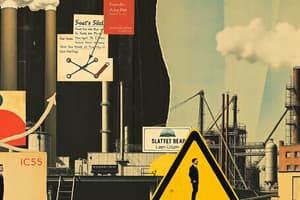Podcast
Questions and Answers
Which industry has the highest rate of fatal injuries per 100,000 workers?
Which industry has the highest rate of fatal injuries per 100,000 workers?
- Mining (correct)
- Construction
- Transportation
- Agriculture
What is a contributing factor to the high fatality rate in the mining industry?
What is a contributing factor to the high fatality rate in the mining industry?
- Complex environments and equipment (correct)
- Limited regulatory oversight
- Accessibility of safety gear
- High levels of automation
Which of the following industries is least likely to be associated with fatal injuries?
Which of the following industries is least likely to be associated with fatal injuries?
- Mining
- Healthcare (correct)
- Transportation
- Agriculture
What safety concern is most prevalent in the transportation industry?
What safety concern is most prevalent in the transportation industry?
Which of the following methods is critical for ensuring safe material handling?
Which of the following methods is critical for ensuring safe material handling?
What is a key characteristic of an accident based on the lecture?
What is a key characteristic of an accident based on the lecture?
Which of the following statements correctly describes an accident?
Which of the following statements correctly describes an accident?
Which option does NOT accurately reflect the definition of an accident?
Which option does NOT accurately reflect the definition of an accident?
What does the term 'hazard' refer to in contrast to an accident?
What does the term 'hazard' refer to in contrast to an accident?
Which statement best describes the relationship between accidents and safety?
Which statement best describes the relationship between accidents and safety?
What is the primary purpose of enhancing machine aesthetics?
What is the primary purpose of enhancing machine aesthetics?
Which of the following is classified as an example of a chemical hazard?
Which of the following is classified as an example of a chemical hazard?
Which action is critical for ensuring electrical safety in a workplace?
Which action is critical for ensuring electrical safety in a workplace?
What is a significant benefit of safeguarding workers from mechanical hazards?
What is a significant benefit of safeguarding workers from mechanical hazards?
Which of the following options is NOT a chemical hazard?
Which of the following options is NOT a chemical hazard?
Why is it important for organizations to adhere to ethical, cost, and legal standards?
Why is it important for organizations to adhere to ethical, cost, and legal standards?
Which of the following is a primary reason for organizations to comply with regulations?
Which of the following is a primary reason for organizations to comply with regulations?
What can be a consequence of failing to meet ethical and legal standards?
What can be a consequence of failing to meet ethical and legal standards?
How might organizations ensure they are meeting legal and ethical standards?
How might organizations ensure they are meeting legal and ethical standards?
Which of the following best describes a potential benefit of meeting ethical standards?
Which of the following best describes a potential benefit of meeting ethical standards?
What is one responsibility employers do not have regarding workplace safety?
What is one responsibility employers do not have regarding workplace safety?
Which responsibility is typically required of employers to ensure a safe workplace?
Which responsibility is typically required of employers to ensure a safe workplace?
Which of the following is NOT a typical part of an employer's duties concerning workplace safety?
Which of the following is NOT a typical part of an employer's duties concerning workplace safety?
In the context of workplace safety, which action is NOT typically required from employers?
In the context of workplace safety, which action is NOT typically required from employers?
What employer responsibility is directly tied to enhancing employee safety?
What employer responsibility is directly tied to enhancing employee safety?
What best describes the nature of an uncontrollable event sequence in the workplace?
What best describes the nature of an uncontrollable event sequence in the workplace?
Which statement reflects an intentional act related to workplace incidents?
Which statement reflects an intentional act related to workplace incidents?
Which of the following best defines a foreseeable consequence of unsafe practices?
Which of the following best defines a foreseeable consequence of unsafe practices?
What is an example of an unsafe condition?
What is an example of an unsafe condition?
What constitutes an uncontrollable event in workplace safety terminology?
What constitutes an uncontrollable event in workplace safety terminology?
Flashcards
Why implement safety standards?
Why implement safety standards?
Reasons for implementing safety standards in the workplace.
What is a hazard?
What is a hazard?
A potential source of harm or danger in the workplace.
Uncontrollable Event Sequence
Uncontrollable Event Sequence
An event that happens unexpectedly and leads to negative outcomes.
Unsafe Condition
Unsafe Condition
Signup and view all the flashcards
Intentional Workplace Damage
Intentional Workplace Damage
Signup and view all the flashcards
Foreseeable Consequence
Foreseeable Consequence
Signup and view all the flashcards
Accident
Accident
Signup and view all the flashcards
Accident (definition)
Accident (definition)
Signup and view all the flashcards
Hazard
Hazard
Signup and view all the flashcards
Risk Management
Risk Management
Signup and view all the flashcards
Predictable Incident
Predictable Incident
Signup and view all the flashcards
Workplace Hazards
Workplace Hazards
Signup and view all the flashcards
Training Employees
Training Employees
Signup and view all the flashcards
PPE Program Effectiveness
PPE Program Effectiveness
Signup and view all the flashcards
Employer Safety Responsibilities
Employer Safety Responsibilities
Signup and view all the flashcards
Personal Protective Equipment (PPE)
Personal Protective Equipment (PPE)
Signup and view all the flashcards
Machine Aesthetics
Machine Aesthetics
Signup and view all the flashcards
Safeguarding Workers from Mechanical Hazards
Safeguarding Workers from Mechanical Hazards
Signup and view all the flashcards
Chemical Hazard
Chemical Hazard
Signup and view all the flashcards
Asbestos Dust
Asbestos Dust
Signup and view all the flashcards
Electrical Safety
Electrical Safety
Signup and view all the flashcards
Most dangerous industry
Most dangerous industry
Signup and view all the flashcards
Safe material handling
Safe material handling
Signup and view all the flashcards
Construction safety
Construction safety
Signup and view all the flashcards
Transportation safety
Transportation safety
Signup and view all the flashcards
Agriculture safety
Agriculture safety
Signup and view all the flashcards
Study Notes
Safety Lecture Summaries
- Safety is defined by the National Safety Council as the control of hazards to manage an acceptable level of risk.
- Hazards are the source of risk.
- Professional safety practice focuses on avoiding or reducing the probability of incidents while minimizing their severity.
- A hazard is the potential for harm.
- The ultimate purpose of safety practices is to attain a state where risks are deemed acceptable.
- Identifying and analyzing hazards for elimination or control is a key design phase characteristic.
- An accident is an undesired event leading to harm or deterioration.
- According to Heinrich's Domino Theory, the initial step leading to an accident is the fault of the person.
- From Marcum's perspective, accidents can be avoided, and liability lies with management.
- Innate human error tendencies contribute to system-induced errors.
- Safety is defined as protection against risks like failure or accidents, and minimizing workplace stress.
- Safety laboratory standards are issued by organizations such as ISO, ASTM, and BSI.
- Employers are responsible for identifying workplace hazards, assigning supervisors for employee training, and evaluating the effectiveness of personal protective equipment (PPE) programs, but not providing free snacks for safety meetings.
- Physical, psychological, and biological hazards are types of workplace hazards, avoiding astrological hazards.
- Electrical hazards include electric shocks, burns, fire, explosions, and arcing. Using devices with automatic current cut-offs and avoiding double insulation are precautions to prevent electrical hazards.
- The fire triangle consists of oxygen, heat, and fuel.
- Workplace fire risks are minimized through limiting flammable materials, using fire risk warnings, and controlling ignition sources.
- Personal protective equipment (PPE) includes eye and face protection, head protection, and foot protection.
- Running to reach tools quickly is not a recommended workshop safety practice.
- Identifying workplace hazards is essential to reduce accidents and improve employee performance.
- Accidents occur when hazards and exposure interact over time.
- Categories of hazards include biological, psychological, social, and ergonomic factors.
- Effective accountability reduces accidents through proper responsibility assignment, safety planning, and adequate training.
- The three primary categories of hazardous materials are physical, chemical, and electrical hazards.
- Heinrich's accident model's ratio is 88:10:2 representing unsafe acts, unsafe conditions, and unpreventable causes.
- The first step in the OSHA Safety and Health Program Model is top management commitment.
- Risks can be reduced, but not fully eliminated.
- The hierarchy of controls prioritizes hazard elimination or substitution before engineering controls, administrative controls, and personal protective equipment (PPE).
- A logical process risk analysis helps allocate funds for maximum risk reduction across departments.
- Engineering controls limit hazards but don't entirely remove them.
- The most common cause of machinery-related injuries is point-of-operation accidents.
- A key safety practice is storing flammable materials in properly ventilated cabinets
- A biological hazard example is mold and bacteria and an example of a chemical hazard is Asbestos dust
- Lifting heavy loads is an example of an ergonomic hazard.
- Safety is crucial for meeting ethical, cost, and legal standards, avoiding public scrutiny, and ensuring productivity, not competition.
- Hazards are unsafe conditions or practices causing harm and risks are quantified by multiplying severity by probability.
- Accidents are uncontrollable sequences of events causing undesirable effects.
- The three significant causes of industrial accidents are employees' actions, environmental conditions, and job task characteristics.
- Errors of omission are failing to act when required.
- The most dangerous industry per fatal injury rate is mining.
- Manual methods are generally considered less safe than automated or mechanized methods for material handling.
Lecture 2 Specific Points
- Safety is defined as being protected from risks like accidents and failures, not just physical fitness.
- Safety includes avoiding all forms of physical labor and reducing work-related stress.
Studying That Suits You
Use AI to generate personalized quizzes and flashcards to suit your learning preferences.




